Download CBSE Class 11 Biology Morphology Of Flowering Plants Notes Set B in PDF format. All Revision notes for Class 11 Biology have been designed as per the latest syllabus and updated chapters given in your textbook for Biology in Class 11. Our teachers have designed these concept notes for the benefit of Class 11 students. You should use these chapter wise notes for revision on daily basis. These study notes can also be used for learning each chapter and its important and difficult topics or revision just before your exams to help you get better scores in upcoming examinations, You can also use Printable notes for Class 11 Biology for faster revision of difficult topics and get higher rank. After reading these notes also refer to MCQ questions for Class 11 Biology given on studiestoday
Revision Notes for Class 11 Biology Chapter 5 Morphology of Flowering Plants
Class 11 Biology students should refer to the following concepts and notes for Chapter 5 Morphology of Flowering Plants in Class 11. These exam notes for Class 11 Biology will be very useful for upcoming class tests and examinations and help you to score good marks
Chapter 5 Morphology of Flowering Plants Notes Class 11 Biology
- Morphology is the study of external forms of organisms.
- A flowering plant (Angiosperm) has 2 parts: Root system (underground part) & Shoot system (portion above the ground).
THE ROOT
It is the underground part formed from radicle of embryo. Root systems are 3 types:
- Tap root system: It consists of primary roots (tap root) and its branches (lateral roots such as secondary roots, tertiary roots). Seen in dicots. Primary root is elongated from radicle. E.g. Mustard plant.
- Fibrous root system: In monocots, primary root is short lived and is replaced by many roots. They originate from the base of stem to form fibrous root system. E.g. Wheat.
- Adventitious root system: Roots that arise from parts other than radicle. E.g. Grass, Monstera and banyan tree.
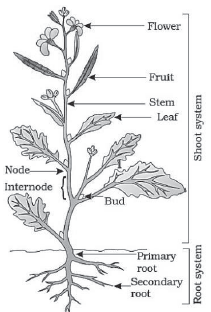
Regions of the Root
- Root cap: It is the covering at the apex of root. It protects the tender apex of the root.
- Region of meristematic activity: Seen above the root cap. Here, the cells are very small, thin-walled and with dense protoplasm. They divide repeatedly.
- Region of elongation: Region just above the meristematic region. Here, cells undergo rapid elongation and enlargement. Helps in growth of the root in length.
- Region of maturation: It is proximal to elongation zone. Here, the cells differentiate and mature.
- Root hairs: Very fine, delicate, thread-like structures formed from epidermal cells in region behind region of
elongation. They absorb water and minerals from the soil.
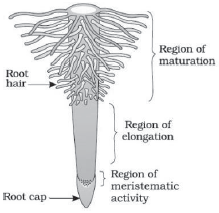
Modifications of Root
In some plants, roots are modified to perform functions other than absorption and conduction. E.g.
o Swollen roots for food storage: E.g. Tap roots of carrot, turnips and adventitious roots of sweet potato.
o Prop roots: Hanging structures that support banyan tree.
o Stilt roots: The supporting roots coming out of the lower nodes of the stem. E.g. maize & sugarcane.
o Pneumatophores: The roots that come out of the ground and grow vertically upwards to get oxygen for respiration.
E.g. Rhizophora growing in swampy areas.
Functions of root
- Absorption of water and minerals from the soil.
- Provide a proper anchorage to the plant parts.
- Storage of reserve food material.
- Synthesis of plant growth regulators.
THE STEM
- It is the ascending part of the axis that develops from the plumule of the embryo of a germinating seed.
- It bears branches, leaves, flowers, fruits, buds (terminal or axillary), nodes and internodes.
- Nodes are the regions of the stem where leaves are born.
- Internodes are the portions between two nodes.
- Young stem is generally green and later often become woody and dark brown.
Functions of stem:
- Spreading out branches bearing leaves, flowers and fruits.
- It conducts water, minerals and photosynthates.
- Food storage, support, protection & vegetative propagation.
Modifications of Stem
o For food storage: E.g. underground stems of potato, ginger, turmeric, zaminkand, Colocasia etc. They also act as organs of perennation to tide over conditions unfavourable for growth.
o Stem tendrils: Slender and spirally coiled structures formed from axillary buds. They help plants to climb. E.g.
Gourds (cucumber, pumpkins, watermelon) & grapevines.
o Thorns: Woody, straight and pointed structures developed from axillary buds. They protect plants from browsing
animals. E.g. Citrus, Bougainvillea.
o Phylloclade: It is a green, flattened or fleshy cylindrical stem containing chlorophyll for photosynthesis. Found in
some plants of arid regions. E.g. Opuntia (flattened stem), Euphorbia (cylindrical stem).
o Stolon: Slender lateral branch that arises from the base of the main axis and after growing aerially for some time arch
downwards to touch the ground. E.g. mint & jasmine.
o Offset: It is a lateral branch with short internodes and each node bearing a rosette of leaves and a tuft of roots. E.g.
aquatic plants like Pistia and Eichhornia.
o Sucker: The lateral branches that originate from the basal underground part of the main stem. It grows horizontally
beneath the soil and come out obliquely upward giving rise to leafy shoots. E.g. Banana, Pineapple & Chrysanthemum.
Underground stems of grass, strawberry etc. spread to new niches. When older parts die, new plants are formed.
THE LEAF
- It is a lateral, flattened structure borne on the stem.
It develops at the node and bears a bud in its axil.
- The axillary bud later develops into a branch.Leaves originate from shoot apical meristems and are arranged in an acropetal order.
- They are important vegetative organs for photosynthesis.
A typical leaf has 3 main parts:
- Leaf base: With this, the leaf is attached to stem. It may bear two lateral small leaf-like structures called stipules.
In monocots, the leaf base expands into a sheath covering the stem partially or wholly. In some leguminous plants,
the leaf base may be swollen. It is called pulvinus.
- Petiole: It helps to hold the leaf blade to light. Long thin flexible petioles allow leaf blades to flutter in wind, thereby cooling leaf and bringing fresh air to leaf surface.
- Lamina (leaf blade): The green expanded part with veins & veinlets. The middle prominent vein is called midrib. Veins provide rigidity to lamina and act as channels of transport for water, minerals & food materials.
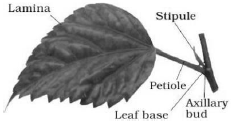
Venation
- It is the arrangement of veins and veinlets in leaf lamina.
- It is 2 types:
o Reticulate venation: Here, the veinlets form a network. It is seen in dicotyledons.
o Parallel venation: Here, the veins run parallel to each other within a lamina. It is seen in monocotyledons.
Types of Leaves
- Simple leaf: Here, leaf lamina is entire or when incised, the incisions do not touch the midrib.
- Compound leaf: Here, the incisions of the lamina reach up to the midrib breaking it into several leaflets.
A bud is seen in the axil of petiole in simple & compound leaves, but not in the axil of leaflets of the compound leaf.
The compound leaves are 2 types.
- Pinnately compound leaf: In this, many leaflets are present on a common axis, the rachis, which represents the midrib of the leaf. E.g. neem.
- Palmately compound leaf: In this, leaflets are attached at a common point (at the tip of petiole). E.g. silk cotton.
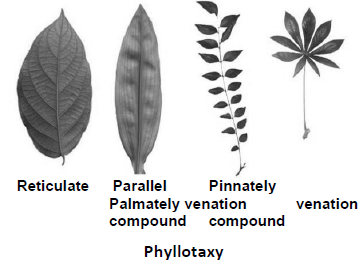
Phyllotaxy
It is the pattern of arrangement of leaves on the stem or branch. It is 3 types:
o Alternate: In this, a single leaf arises at each node in alternate manner. E.g. China rose, mustard & sun flower.
o Opposite: In this, a pair of leaves arise at each node and lie opposite to each other. E.g. Calotropis and guava.
o Whorled: In this, more than two leaves arise at a node and form a whorl. E.g. Alstonia.
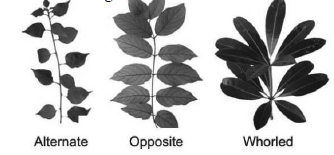
Modifications of Leaves
- Leaves are modified to perform functions other than photosynthesis. E.g.
o Tendrils: For climbing. E.g. peas.
o Spines: For defense. E.g. cacti.
o Fleshy leaves: To store food. E.g. onion and garlic.
- In plants such as Australian acacia, the leaves are small and short-lived. The petioles in these plants expand, become green and synthesise food.
- Leaves of some insectivorous plants (e.g. pitcher plant, Venus-fly trap) are also modified leaves.
THE FLOWER AND THE INFLORESCENCE
- A flower is a modified shoot wherein the shoot apical meristem changes to floral meristem.
- Internodes do not elongate and the axis gets condensed.
- The apex produces different kinds of floral appendages laterally at successive nodes instead of leaves.
- When a shoot tip transforms into a flower, it is solitary.
- The arrangement of cluster of flowers on the floral axis is called inflorescence.
- Based on whether the apex gets converted into a flower or continues to grow, inflorescences are 2 types: Racemose
and Cymose.
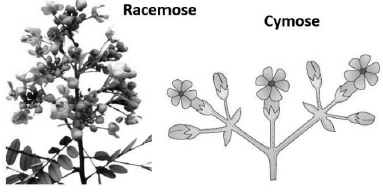
o Racemose: In this, the main axis continues to grow.
Flowers are borne laterally in an acropetal succession.
o Cymose: In this, main axis terminates in a flower, hence is limited in growth. Flowers are borne in a basipetal order.
THE FLOWER
- It is the reproductive unit in the angiosperms.
- It is meant for sexual reproduction.
- A flower has a stalk (pedicel). Its swollen end is called thalamus (receptacle).
- Reduced leaf found at the base of the pedicel is called bracts. Flowers with bracts are called bracteate and those without bracts, ebracteate.
- A typical flower has 4 kinds of whorls arranged on thalamus- calyx, corolla, androecium & gynoecium.
- Calyx & corolla are accessory organs, while androecium and gynoecium are reproductive organs.
- In flowers like lily, the calyx and corolla are not distinct. It is termed as perianth.
- When a flower has both androecium and gynoecium, it is bisexual. A flower having either only androecium or only gynoecium is unisexual.
Based on symmetry, flowers are 3 types:
o Actinomorphic (radial symmetry): Here, a flower can be divided into 2 equal radial halves in any radial plane
passing through the centre. E.g. mustard, datura, chilli.
o Zygomorphic (bilateral symmetry): Here, a flower can be divided into two similar halves only in a particular vertical
plane. E.g. pea, gulmohur, bean, Cassia.
o Asymmetric (irregular): Here, a flower cannot be divided into two similar halves by any vertical plane passing
through the centre. E.g. canna.
Based on number of floral appendages, flowers are classified as follows:
o Trimerous: Floral appendages are multiple of 3.
o Tetramerous: Floral appendages are multiple of 4.
o Pentamerous: Floral appendages are multiple of 5.
Based on the position of calyx, corolla and androecium in respect of the ovary on thalamus, the flowers are 3 types:
o Hypogynous: Here, gynoecium occupies the highest position while other parts are situated below it. The ovary
is superior. E.g. mustard, China rose & brinjal.
o Perigynous: Here, gynoecium is situated in the centre and other parts are located on the rim of the thalamus at the
same level. Ovary is half inferior. E.g. plum, rose, peach.
o Epigynous: Here, the margin of thalamus grows upward enclosing the ovary completely and getting fused with it.
Other parts arise above the ovary. The ovary is inferior. E.g. Guava, cucumber, ray florets of sunflower.
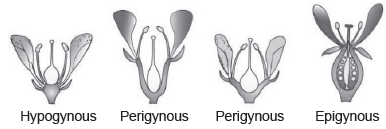
Parts of a Flower
a) Calyx
- It is the outermost whorl of flower. It is made of sepals.
- Generally, sepals are green, leaf like and protect the flower in the bud stage.
- The calyx may be gamosepalous (sepals united) or polysepalous (sepals free).
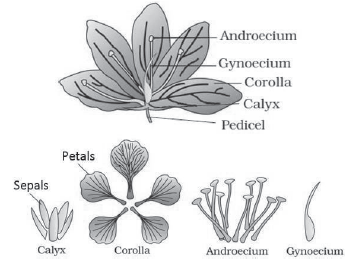
b) Corolla
- It is the whorl inner to calyx. It is composed of petals.
- Petals have bright colour to attract insects for pollination.
- Corolla may be gamopetalous (petals united) or polypetalous (petals free).
- Shape and colour of corolla vary in plants. Corolla may be tubular, bell-shaped, funnel-shaped or wheel-shaped.
Aestivation: It is the mode of arrangement of sepals and petals in floral bud. It is many types:
o Valvate: Sepals or petals in a whorl just touch one another at the margin, without overlapping. E.g. Calotropis.
o Twisted: One margin of the appendage overlaps that of the next one and so on. E.g. China rose, lady’s finger & cotton.
o Imbricate: Margins of sepals or petals overlap one another but not in any particular direction. E.g. Cassia & gulmohur.
o Vexillary (papilionaceous): In this, there are five petals; the largest (standard) overlaps the two lateral petals
(wings) which in turn overlap the two smallest anterior petals (keel). E.g. pea & bean.
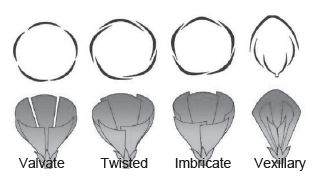
c) Androecium
- The male reproductive part composed of stamens.
- Each stamen represents the male reproductive organ. It consists of a stalk (filament) and an anther.
- Each anther is usually bilobed.
- Each lobe has 2 chambers called pollen-sacs.
- In pollen-sacs, pollen grains are produced.
- A sterile stamen is called staminode.
- When stamens are attached to petals, they are epipetalous.
E.g. brinjal. When stamens are attached to perianth they are epiphyllous. E.g. lily.
- If the stamens are free, it is called polyandrous.
If they are united, it is called synandrous. It is many types:
o Monadelphous: Stamens are united into one bunch or one bundle. E.g. China rose.
o Diadelphous: Stamens are united into two bundles. E.g. pea.
o Polyadelphous: Stamens are united into more than two bundles. E.g. citrus.
There may be a variation in the length of filaments within a flower. E.g. Salvia and mustard.
d) Gynoecium (Pistil)
The female reproductive part made up of one or more carpels.
A carpel has 3 parts:
o Stigma: It is the receptive surface for pollen grains. It is usually at the tip of the style.
o Style: An elongated tube that connects ovary to stigma.
o Ovary: It is the enlarged basal part on which the style lies.
Each ovary bears one or more ovules attached to a flattened, cushion-like placenta.
Polycarpellary pistils (pistil with many carpels) are 2 types:
o Apocarpous: Carpels are free. E.g. lotus and rose.
o Syncarpous: Carpels are fused. E.g. mustard and tomato.
Placentation: It is the arrangement of ovules on the placenta within the ovary. It is many types:
o Marginal: Here, the placenta forms a ridge along the ventral suture of the ovary and the ovules are borne on this
ridge forming two rows. E.g. pea.
o Axile: Here, the placenta is axial and the ovules are attached to it in a multilocular ovary. E.g. China rose, tomato and lemon.
o Parietal: Here, the ovules develop on the inner wall of the ovary or on peripheral part. Ovary is one-chambered but it becomes two-chambered due to the formation of the false septum. E.g. mustard and Argemone.
o Basal: Here, placenta develops at the base of ovary and a single ovule is attached to it. E.g. sunflower, marigold.
o Free central: Here, ovules are borne on central axis and septa are absent. E.g. Dianthus and Primrose.
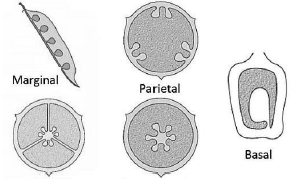
After fertilisation, the ovules develop into seeds and the ovary matures into a fruit.
THE FRUIT
- It is a ripened ovary developed after fertilisation.
- It is a characteristic feature of the flowering plants.
- A fruit formed without fertilisation of the ovary is called parthenocarpic fruit.
- In mango & coconut, fruit is called a drupe. They are one seeded and develop from monocarpellary superior ovaries.
A fruit consists of
o Pericarp (fruit wall): It may be dry or fleshy.
Thick and fleshy pericarp is differentiated into outer epicarp, middle mesocarp and inner endocarp.
o Seeds
- In mango, the pericarp is well differentiated into thin epicarp, fleshy edible mesocarp and stony hard endocarp.
In coconut, the mesocarp is fibrous.
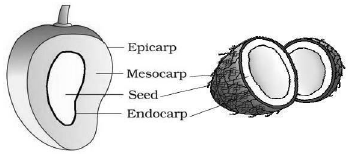
THE SEED
- It is the mature ovule developed after fertilisation.
- A seed is made up of a seed coat and an embryo.
- Embryo is made up of a radicle, an embryonal axis and one (e.g. wheat, maize) or 2 cotyledons (e.g. gram & pea).
Structure of a Dicotyledonous Seed
- The outermost covering of a seed is the seed coat.
- Seed coat has 2 layers: outer testa and inner tegmen.
- On the seed coat, there is a scar called hilum through which the developing seeds are attached to the fruit.
- Above the hilum is a small pore called the micropyle.

- Within the seed coat is the embryo, consisting of an embryonal axis and two cotyledons.
- The cotyledons are often fleshy and full of reserve food materials. At the two ends of the embryonal axis, the
radicle and plumule are present.
- In some seeds such as castor, the endosperm is formed due to double fertilisation. It is a food storing tissue.
- In plants such as bean, gram and pea, the seeds are nonendospermous (endosperm is not seen in mature seeds).
Structure of Monocotyledonous Seed
- Generally, monocot seeds are endospermic but some are non-endospermic (e.g. orchids).
- In cereals such as maize, the seed coat is membranous and generally fused with the fruit wall.
- The endosperm is bulky and stores food.
The outer covering of endosperm separates the embryo by a protein layer called aleurone layer.
- The embryo is small and situated in a groove at one end of the endosperm. It consists of one large and shield shaped cotyledon known as scutellum and a short axis with a plumule and a radicle.
- The plumule is protected in a sheath called coleoptile and radicle is protected in a sheath called coleorhiza.

SEMI-TECHNICAL DESCRIPTION OF A TYPICAL FLOWERING PLANT
- The plant is described beginning with its habit, vegetative characters and then floral characters.
- Then a floral diagram and a floral formula are presented.
- Floral formula is represented by some symbols. They are
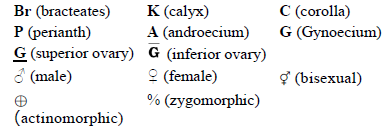
- Fusion is indicated by enclosing the figure within bracket and adhesion by a line drawn above the symbols of the floral parts.
- A floral diagram gives information about the number of parts of a flower, their arrangement and relation.
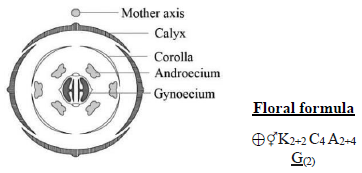
Floral diagram of mustard plant (Family: Brassicaceae)
- Floral formula also shows cohesion and adhesion within parts of whorls and in between whorls.
SOME IMPORTANT FAMILIES
Fabaceae
This family was earlier called Papilonoideae, a subfamily of family Leguminosae. It is distributed all over the world.
Vegetative Characters:
o Trees, shrubs, herbs; root with root nodules.
o Stem: erect or climber.
o Leaves: alternate, pinnately compound or simple; leaf base, pulvinate; stipulate; venation reticulate.
Floral characters:
o Inflorescence: racemose.
o Flower: bisexual, zygomorphic.
o Calyx: sepals five, gamosepalous; valvate/imbricate aestivation.
o Corolla: petals five, polypetalous, papilionaceous, consisting of a posterior standard, two lateral wings, two anterior ones forming a keel (enclosing stamens and pistil), vexillary aestivation.
o Androecium: ten, diadelphous, anther dithecous.
o Gynoecium: ovary superior, mono carpellary, unilocular with many ovules, style single.
o Fruit: legume; seed: one to many, non-endospermic.
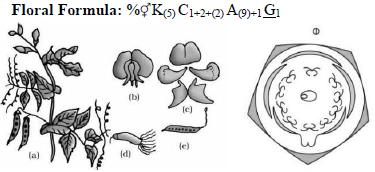
Pisum sativum (pea) plant: (a) Flowering twig (b) Flower (c) Petals (d) Reproductive parts (e) L.S.carpel (f) Floral diagram
Economic importance:
o Pulses: E.g. gram, arhar, sem, moong, soyabean.
o Edible oil: E.g. soyabean, groundnut.
o Dye: E.g. Indigofera.
o Fibres: E.g. sun hemp.
o Fodder: E.g. Sesbania, Trifolium.
o Ornamentals: E.g. lupin, sweet pea.
o Medicine: E.g. muliathi.
Solanaceae (Potato family)
It is a large family. It is widely distributed in tropics, subtropics and even temperate zones.
Vegetative Characters:
o Plants mostly herbs, shrubs and small trees.
o Stem: herbaceous rarely woody, aerial; erect, cylindrical, branched, solid or hollow, hairy or glabrous, underground
stem in potato (Solanum tuberosum).
o Leaves: alternate, simple, rarely pinnately compound, exstipulate; venation reticulate.
Floral Characters:
o Inflorescence: Solitary, axillary or cymose as in Solanum.
o Flower: bisexual, actinomorphic.
o Calyx: sepals five, united, persistent, valvate aestivation.
o Corolla: petals five, united; valvate aestivation.
o Androecium: stamens five, epipetalous.
o Gynoecium: bicarpellary obligately placed, syncarpous; ovary superior, bilocular, placenta swollen with many ovules,axile.
o Fruits: berry or capsule.
o Seeds: many, endospermous
o Floral Formula: ⊕⚥K(5) C(5)A(5) G(2)
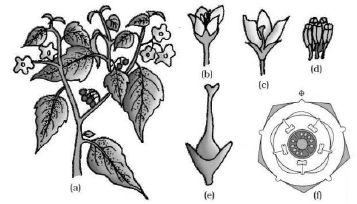
Solanum nigrum (makoi) plant: (a) Flowering twig (b) Flower (c) L.S. of flower (d) Stamens (e) Carpel (f) Floral diagram
Economic Importance:
o Food: E.g. tomato, brinjal, potato
o Spice: E.g. chilli
o Medicine: E.g. belladonna, ashwagandha.
o Fumigatory: E.g. tobacco.
o Ornamentals: E.g. petunia.
Lilaceae (Lily family)
A characteristic representative of monocotyledonous plants.
It is distributed worldwide.
Vegetative characters:
o Perennial herbs with underground bulbs/corms/ rhizomes.
o Leaves mostly basal, alternate, linear, exstipulate with parallel venation.
Floral characters:
o Inflorescence: solitary / cymose; often umbellate clusters.
o Flower: bisexual; actinomorphic.
o Perianth tepal six (3+3), often united into tube; valvate aestivation.
o Androecium: stamen six, (3+3).
o Gynoecium: tricarpellary, syncarpous, ovary superior, trilocular with many ovules; axile placentation.
o Fruit: capsule, rarely berry.
o Seed: endospermous
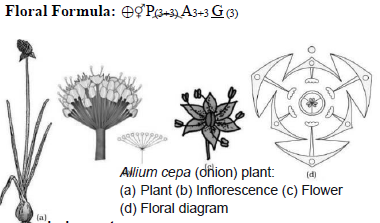
Economic Importance:
o Ornamentals: E.g. tulip, Gloriosa
o Medicine: E.g. Aloe
o Vegetables: E.g. Asparagus
o Colchicines: E.g. Colchicum autumnale
| CBSE Class 11 Biology The Living World Notes Set A |
| CBSE Class 11 Biology The Living World Notes Set B |
| CBSE Class 11 Biology Plant Kingdom Notes Set A |
| CBSE Class 11 Biology Plant Kingdom Notes Set B |
| CBSE Class 11 Biology Plant Kingdom Notes Set C |
| CBSE Class 11 Biology Animal Kingdom Notes Set A |
| CBSE Class 11 Biology Animal Kingdom Notes Set B |
| CBSE Class 11 Biology Animal Kingdom Notes Set C |
| CBSE Class 11 Biology Morphology Of Flowering Plants Notes Set A |
| CBSE Class 11 Biology Morphology Of Flowering Plants Notes Set B |
| CBSE Class 11 Biology Structural Organisation In Animals Notes Set A |
| CBSE Class 11 Biology Structural Organisation In Animals Notes Set B |
| CBSE Class 11 Biology Cell The Unit Of Life Notes Set A |
| CBSE Class 11 Biology Cell The Unit Of Life Notes Set B |
| CBSE Class 11 Biology Cell The Unit Of Life Notes Set C |
| CBSE Class 11 Biology Biomolecules Notes Set A |
| CBSE Class 11 Biology Biomolecules Notes Set B |
| CBSE Class 11 Biology Respiration In Plants Notes Set A |
| CBSE Class 11 Biology Respiration In Plants Notes Set B |
| CBSE Class 11 Biology Plant Growth And Development Notes Set A |
| CBSE Class 11 Biology Plant Growth And Development Notes Set B |
| CBSE Class 11 Biology Breathing And Exchange Of Gases Notes Set A |
| CBSE Class 11 Biology Breathing And Exchange Of Gases Notes Set B |
| CBSE Class 11 Biology Body Fluids And Circulation Notes Set A |
| CBSE Class 11 Biology Body Fluids And Circulation Notes Set B |
| CBSE Class 11 Biology Neural Control And Coordination Notes Set A |
| CBSE Class 11 Biology Neural Control And Coordination Notes Set B |
| CBSE Class 11 Biology Chemical Coordination and Integration Notes Set A |
| CBSE Class 11 Biology OTBA Guidance Document Set A |
| CBSE Class 11 Biology OTBA Guidance Document Set B |
CBSE Class 11 Biology Chapter 5 Morphology of Flowering Plants Notes
We hope you liked the above notes for topic Chapter 5 Morphology of Flowering Plants which has been designed as per the latest syllabus for Class 11 Biology released by CBSE. Students of Class 11 should download and practice the above notes for Class 11 Biology regularly. All revision notes have been designed for Biology by referring to the most important topics which the students should learn to get better marks in examinations. Our team of expert teachers have referred to the NCERT book for Class 11 Biology to design the Biology Class 11 notes. After reading the notes which have been developed as per the latest books also refer to the NCERT solutions for Class 11 Biology provided by our teachers. We have also provided a lot of MCQ questions for Class 11 Biology in the notes so that you can learn the concepts and also solve questions relating to the topics. We have also provided a lot of Worksheets for Class 11 Biology which you can use to further make yourself stronger in Biology.
You can download notes for Class 11 Biology Chapter 5 Morphology of Flowering Plants for latest academic session from StudiesToday.com
Yes, the notes issued for Class 11 Biology Chapter 5 Morphology of Flowering Plants have been made available here for latest CBSE session
There is no charge for the notes for CBSE Class 11 Biology Chapter 5 Morphology of Flowering Plants, you can download everything free of charge
www.studiestoday.com is the best website from which you can download latest notes for Chapter 5 Morphology of Flowering Plants Biology Class 11
Come to StudiesToday.com to get best quality topic wise notes for Class 11 Biology Chapter 5 Morphology of Flowering Plants

